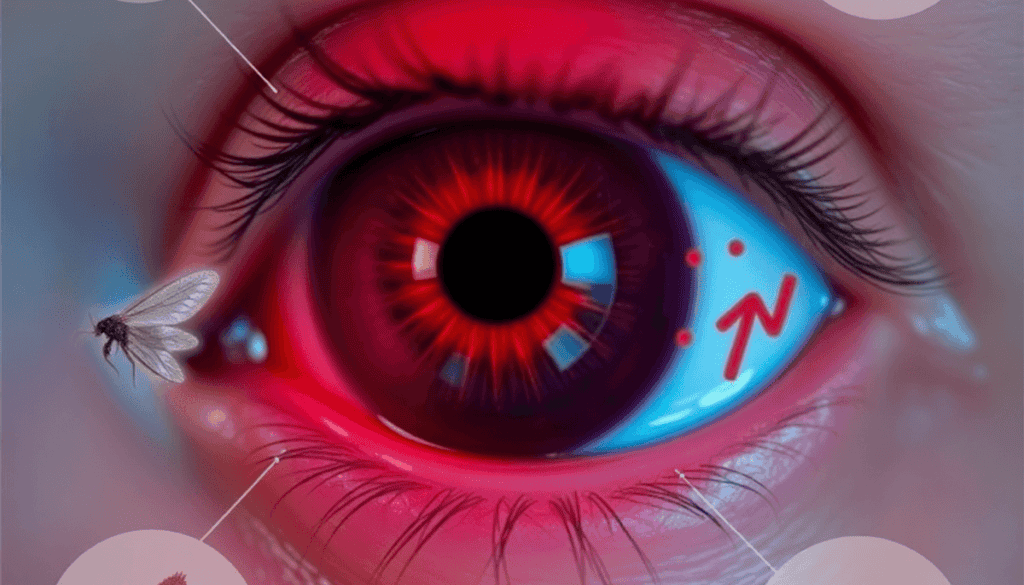Red, Itchy Eyes? How Pharmacists Treat Allergic Conjunctivitis in Ontario
Introduction
Red, Itchy Eyes? How Pharmacists Treat Allergic Conjunctivitis in Ontario addresses a common yet often overlooked eye condition known as allergic conjunctivitis. This inflammation of the conjunctiva causes discomfort through redness, itching, and watery eyes. The condition arises when your eyes react to allergens like pollen, dust, or pet dander.
Pharmacists in Ontario play a crucial role in managing allergic conjunctivitis. Since October 2023, their expanded scope allows them to assess symptoms, recommend treatments, and prescribe medications for this minor ailment. This accessibility provides timely relief without the need for an immediate doctor’s visit.
Timely and effective treatment is essential to prevent complications such as worsening inflammation or secondary infections. Ignoring red, itchy eyes can prolong discomfort and impact daily activities. Understanding how pharmacists support you with personalized treatment options empowers better eye health and faster recovery.
Understanding Allergic Conjunctivitis
Allergic conjunctivitis is an eye condition marked by inflammation of the conjunctiva—the thin membrane covering the white part of the eye and lining the inside of the eyelids. This inflammation occurs when the immune system reacts to allergens, triggering symptoms that can cause significant discomfort.
Causes
Causes of allergic conjunctivitis typically involve exposure to environmental allergens such as:
- Pollen from trees, grasses, and weeds
- Pet dander
- Dust mites
- Mold spores
- Smoke or chemical irritants
When these allergens come into contact with the eye, they prompt an immune response leading to release of histamine and other chemicals responsible for inflammation.
Symptoms
Common symptoms experienced by individuals include:
- Redness in one or both eyes
- Persistent itching sensation
- Watery or teary eyes
- Swelling of the eyelids or conjunctiva
- A burning or gritty feeling
Symptoms usually affect both eyes simultaneously and tend to worsen during allergy seasons or after exposure to specific triggers. The intensity can range from mild irritation to severe discomfort affecting daily activities. Recognizing these classic signs helps in prompt management and reduces risk of complications.
In some cases, individuals may also suffer from bladder infections, which can complicate their overall health condition. Additionally, understanding drug interactions with common supplements is crucial for better health outcomes, especially when managing multiple health issues.
For those who might require medication for managing these conditions, it’s essential to be aware of the various ADHD medication options available, like Vyvanse and Concerta. Furthermore, if you’re considering online prescription delivery for convenience, be sure to debunk any myths about online prescription delivery that may deter you from using this service.
Lastly, it’s important to note that pharmacies are increasingly becoming a vital part of accessible healthcare, providing support not just for physical ailments but also for mental health needs through medication management and early intervention strategies.
Role of Pharmacists in Ontario’s Healthcare System
Pharmacists in Ontario have undergone a significant expansion in their professional responsibilities, known as the expanded scope. This change allows them to actively participate in managing various health conditions beyond traditional roles, including the authority to prescribe medications for selected minor ailments.
What are Minor Ailments?
Minor ailments are defined as common health issues that require minimal intervention or self-care, have a short duration, and typically do not need extensive diagnostic testing. Examples include:
- allergic conjunctivitis
- cold sores
- urinary tract infections
Managing these conditions within the pharmacy setting improves access to timely care and reduces pressure on other healthcare providers such as family physicians and emergency departments.
Prescribing Authority of Pharmacists
The prescribing authority granted to pharmacists enables them to assess symptoms, recommend appropriate treatments, and prescribe medications safely. This authority is especially important for conditions like allergic conjunctivitis, where prompt relief can prevent complications and improve quality of life. Pharmacists’ ability to provide immediate care supports more efficient healthcare delivery by offering convenient and accessible treatment options directly at the community level.
This expanded role demands rigorous training and adherence to clinical guidelines, ensuring that pharmacists maintain high standards of patient care while optimizing outcomes for those seeking help with minor ailments.
Improving Accessibility through Online Pharmacies
Moreover, the rise of online pharmacies has significantly improved accessibility for mobility-limited patients by leveraging telepharmacy innovations. These advancements allow patients to receive necessary medications without the need for physical travel.
Transforming Healthcare with Same-Day Prescription Delivery
In addition, services like same-day prescription delivery are transforming healthcare in Toronto. Such services enhance medication access, increase patient convenience, and overall efficiency of the healthcare system.
Importance of Medication Management
However, it’s crucial for patients to understand how to manage their medications effectively. For instance, if a patient misses a dose, it could lead to complications if not handled properly. Therefore, expert advice from pharmacists on managing missed doses is invaluable.
Treatment Approaches by Pharmacists for Allergic Conjunctivitis
1. Advising on Allergen Avoidance Strategies
Pharmacists play a crucial role in guiding patients through allergic conjunctivitis treatment options, starting with the foundation of managing symptoms—allergen avoidance strategies. Avoiding exposure to allergens is essential because it directly reduces the triggers causing inflammation and irritation of the conjunctiva.
Pharmacists emphasize the importance of identifying personal allergens, which often include:
- Pollen from trees, grasses, and weeds
- Dust mites
- Pet dander
- Mold spores
- Certain cosmetics or airborne chemicals
Understanding what specifically causes your allergic conjunctivitis helps target prevention efforts effectively.
Practical strategies to minimize exposure include:
- Keeping windows closed during high pollen seasons to prevent allergens from entering indoor spaces.
- Using air purifiers with HEPA filters to reduce airborne particles inside homes.
- Regularly washing bedding and curtains in hot water to remove dust mites.
- Avoiding outdoor activities when pollen counts are elevated, especially early morning or windy days.
- Limiting contact with pets known to trigger symptoms or bathing pets frequently to reduce dander.
- Wearing wrap-around sunglasses outdoors to shield eyes from allergens.
- Avoiding rubbing your eyes, which can worsen irritation and increase allergen contact.
Pharmacists often provide tailored advice based on seasonal patterns and individual lifestyles. They also educate patients on reading local pollen forecasts and planning daily routines accordingly.
Proper allergen avoidance decreases reliance on medications and can significantly improve quality of life when dealing with red, itchy eyes caused by allergic conjunctivitis. This approach works hand-in-hand with other treatment modalities like pharmacological interventions, creating a comprehensive management plan for patients visiting Ontario pharmacies.
For those seeking convenience in accessing these medications, exploring options offered by online pharmacies in Toronto may be beneficial.
2. Recommending Non-pharmacological Measures for Symptom Relief
Pharmacists in Ontario emphasize several non-pharmacological measures for allergic conjunctivitis that complement allergen avoidance strategies and medication use. These approaches provide relief from common symptoms like redness, itching, and discomfort.
Cold compresses are a simple yet effective method to reduce inflammation and soothe irritated eyes. Applying a clean, cool cloth over closed eyelids helps constrict blood vessels, which decreases redness and swelling. Patients often report immediate comfort from this practice, making it a valuable first-line measure.
Tear substitutes, or artificial tears, play a crucial role in managing dryness associated with allergic conjunctivitis. They help dilute allergens on the eye surface and restore moisture, reducing irritation caused by dryness. Pharmacists recommend preservative-free options for frequent use to avoid further eye sensitivity.
These non-drug approaches are essential components of allergic conjunctivitis treatment options, addressing symptoms directly while supporting overall eye health before or alongside pharmacological therapies. For more comprehensive symptom relief, it’s also important to explore the latest allergy treatments, which include both OTC antihistamines and prescription options.
3. Prescribing Antihistamine-containing Eye Drops: A Common Approach
Antihistamine-containing eye drops are a key treatment option for allergic conjunctivitis. These medications work by blocking histamine receptors in the eye tissues, directly targeting the root cause of itching and redness. Histamine is the chemical released during allergic reactions that triggers inflammation and discomfort. By preventing histamine from binding to receptors, antihistamines reduce symptoms quickly and effectively.
How Levocabastine Eye Drops Work
Levocabastine eye drops are commonly prescribed by pharmacists in Ontario for allergic conjunctivitis. Levocabastine acts as a selective H1-antihistamine, providing rapid relief from itching and redness without causing significant side effects like drowsiness. It is well-tolerated by most patients and suitable for frequent use during allergy seasons or periods of high allergen exposure.
Combining Medication with Allergen Avoidance
Pharmacists combine prescribing levocabastine eye drops with allergen avoidance strategies to enhance treatment effectiveness and minimize recurrence of symptoms. This approach addresses both symptom relief and underlying triggers for red, itchy eyes, allowing patients to regain comfort efficiently.
Addressing Misconceptions About Online Prescription Safety
While discussing medication prescriptions, it’s essential to address common misconceptions about online prescription safety. Understanding these aspects can lead to safer medication use, whether it’s for antihistamine eye drops or other prescriptions.
Exploring Alternative Treatments: B12 Injections
In some cases, allergies may be linked to deficiencies such as vitamin B12. For those considering alternative treatments, B12 injections could be an option worth exploring. These injections can effectively treat vitamin B12 deficiency, which may indirectly alleviate certain allergy symptoms.
4. Using Mast-cell Stabilizing Agents to Manage Inflammation
Mast-cell stabilizing agents serve as an important allergic conjunctivitis treatment option by targeting the underlying inflammatory process. These agents prevent the release of histamine and other chemical mediators from mast cells, which play a key role in causing redness, swelling, and itching in the eyes.
Two common mast-cell stabilizers prescribed by pharmacists in Ontario include:
-
Sodium Cromolyn
This eye drop helps inhibit mast cell degranulation, reducing inflammation and preventing symptom flare-ups. It is generally well-tolerated with minimal side effects, but like any medication, it may still cause some adverse effects. -
Nedocromil
Similar to sodium cromolyn, nedocromil stabilizes mast cells but may offer longer-lasting relief due to its extended duration of action. It can be preferred for patients needing more sustained control of symptoms.
In such cases where side effects are experienced, it’s crucial to have a support system in place. Pharmacies play a significant role in managing these side effects from new medications, offering expert care, support, and personalized patient education.
Incorporating mast-cell stabilizing agents complements allergen avoidance strategies and antihistamine use, providing a comprehensive approach to managing red, itchy eyes caused by allergic conjunctivitis. Pharmacists tailor treatment based on symptom severity and patient response to optimize care outcomes.
5. Offering Olopatadine-containing Eye Drops as a Stronger Therapy Option
Olopatadine-containing eye drops are a powerful treatment option for allergic conjunctivitis, especially for individuals with more severe symptoms. Unlike antihistamines or mast-cell stabilizers alone, olopatadine works in two ways: it blocks histamine receptors and stabilizes mast cells, preventing further release of inflammatory substances.
Key benefits include:
- Quick relief from intense itching and redness.
- Decrease in both early and late-phase allergic reactions.
- Convenient dosing schedules that make it easier for patients to stick to the treatment plan.
Pharmacists in Ontario use olopatadine-containing eye drops when avoiding allergens and using milder therapies do not effectively control symptoms. This medication targets multiple pathways involved in allergic inflammation, providing a stronger treatment option to reduce discomfort and enhance the quality of life for patients with persistent or severe allergic conjunctivitis.
In situations where the eye drops alone are not enough, pharmacists may also consider other treatment options such as weight loss injections like Ozempic or Mounjaro. These injections can be beneficial for patients whose allergies are worsened by certain health conditions related to weight. For individuals exploring these options, it is essential to compare Ozempic and Mounjaro to determine which one aligns best with their specific health goals.
Furthermore, when it comes to obtaining these medications, patients have the flexibility to choose between various delivery methods. Whether they prefer using a courier service or opting for mail delivery for their prescriptions, it is crucial to compare both options to ensure promptness, safety, and convenience in receiving their treatments.
Patient Education and Precautions During Treatment
Pharmacists emphasize patient education on contact lens care as a critical part of managing allergic conjunctivitis. Wearing contact lenses during an active eye infection can worsen symptoms and delay healing. Patients are advised to:
- Remove contact lenses immediately upon noticing redness or irritation.
- Avoid using lenses until symptoms fully resolve.
- Disinfect or replace lenses and storage cases before resuming use.
Maintaining hygiene practices during treatment helps prevent spreading the allergen or secondary infections. Key recommendations include:
- Frequent handwashing with soap, especially before touching the eyes or applying eye drops.
- Avoiding rubbing or scratching the eyes, which can increase inflammation and damage the conjunctiva.
- Using clean tissues to gently wipe away discharge, disposing of them immediately after use.
- Keeping pillows, towels, and bedding clean to reduce allergen exposure.
In these situations, personalized pharmaceutical care becomes essential. Pharmacists educate patients on proper application techniques for prescribed eye drops to ensure maximum efficacy and reduce risks of contamination or side effects.
Understanding these precautions supports faster recovery and minimizes complications associated with allergic conjunctivitis. Pharmacists reinforce the importance of adherence to these guidelines while monitoring for any worsening symptoms that may require referral to a physician. Their role in this process highlights why your health care team needs a pharmacist, given their expertise, accessibility, and key role in patient care and public health.
Referral Process and Continuing Education for Pharmacists in Ontario
Pharmacists play a crucial role in identifying red flag symptoms that require prompt medical attention beyond minor ailment management. When treating allergic conjunctivitis, pharmacists follow a structured doctor referral process if patients exhibit:
- Severe eye pain or vision changes
- Significant swelling around the eyes
- Presence of purulent discharge or signs of bacterial infection
- No improvement or worsening symptoms after 48 hours of treatment
This approach ensures that potentially serious conditions are not overlooked while providing timely care for typical allergic conjunctivitis cases.
In some instances, pharmacists may also assist in requesting prescription renewals without the need for a doctor’s visit in Ontario. This can be done using online consults, pharmacists, and telehealth services, offering patients more accessible healthcare options.
Pharmacists in Ontario must meet specific continuing education requirements to maintain their authorization for prescribing medications for minor ailments like allergic conjunctivitis. These include:
- Completing mandatory orientation programs focused on minor ailment prescribing protocols
- Participating in ongoing training to stay updated on best practices, new treatments, and safety guidelines
- Engaging in regular competency assessments to uphold high standards of patient care
Such education equips pharmacists with the knowledge and confidence to manage red, itchy eyes effectively, ensuring safe, evidence-based interventions within their expanded scope.
The combination of a clear referral protocol and rigorous continuing education supports pharmacists as accessible healthcare providers capable of managing allergic conjunctivitis while safeguarding patient health.
FAQs (Frequently Asked Questions)
What is allergic conjunctivitis and what causes it?
Allergic conjunctivitis is an eye condition characterized by inflammation caused by allergens such as pollen, dust, or pet dander. It leads to symptoms like red, itchy eyes and discomfort.
How do pharmacists in Ontario play a role in treating allergic conjunctivitis?
Pharmacists in Ontario have an expanded scope that allows them to manage minor ailments including allergic conjunctivitis. They can assess symptoms, recommend treatments, advise on allergen avoidance, and prescribe appropriate medications such as antihistamine-containing eye drops.
What allergen avoidance strategies do pharmacists recommend for managing allergic conjunctivitis?
Pharmacists advise patients to identify and minimize exposure to known allergens causing their symptoms. This includes measures like keeping windows closed during high pollen seasons, using air purifiers, avoiding pet dander, and maintaining clean environments to reduce dust accumulation.
What treatment options are available through pharmacists for allergic conjunctivitis?
Treatment approaches include non-pharmacological measures like cold compresses and tear substitutes for symptom relief; prescribing antihistamine-containing eye drops such as levocabastine; using mast-cell stabilizing agents like sodium cromolyn or nedocromil; and offering stronger therapy options like olopatadine-containing eye drops for severe cases.
How do antihistamine and mast-cell stabilizing eye drops help with allergic conjunctivitis?
Antihistamine-containing eye drops alleviate itching and redness by blocking histamine receptors, providing quick relief. Mast-cell stabilizing agents prevent the release of histamine from mast cells, reducing inflammation over time and helping prevent symptom flare-ups.
When should patients with red, itchy eyes seek referral to a doctor instead of pharmacist treatment?
Patients experiencing red flag symptoms such as severe pain, vision changes, discharge indicating infection, or symptoms not improving with pharmacist-managed treatment should be referred promptly to a doctor. Pharmacists also follow continuing education requirements to recognize when referral is necessary for patient safety.



